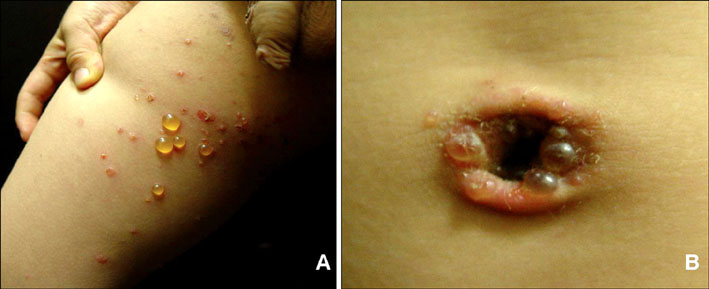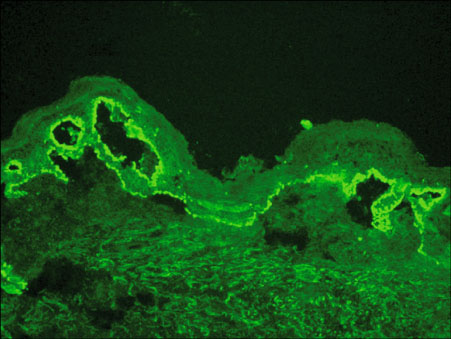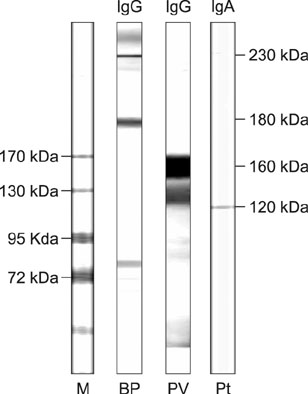Ann Dermatol.
2011 May;23(2):209-212. 10.5021/ad.2011.23.2.209.
A Case of Chronic Bullous Disease of Childhood That Was Reactive to the Antigen of 120 kDa (LAD-1)
- Affiliations
-
- 1Department of Dermatology, Chonnam National University Medical School, Gwangju, Korea. jbmlee@chonnam.ac.kr
- KMID: 2156665
- DOI: http://doi.org/10.5021/ad.2011.23.2.209
Abstract
- Chronic bullous disease of childhood (CBDC) is an autoimmune blistering disease that is characterized by Immunoglobulin A (IgA) deposits at the basement membrane zone. IgA autoantibodies (aAbs) from the serum of patients with CBDC react with antigens of 97 kDa (LABD97) and 120 kDa (LAD-1), and both of which are fragments of the extracellular domain of bullous pemphigoid 180 (BP180, type XVII collagen). The CBDC sera reacts with the immunodominant NC16a domain of BP180, which is the major region recognized by IgG aAbs in patients with bullous pemphigoid. A five-year-old boy presented with multiple pruritic tense blisters on the umbilical and inguinal areas for six weeks. The direct immunofluorescence of the perilesional area demonstrated linear deposits of IgA at the basement membrane zone. Using immunoblotting and an enzyme linked immunosorbent assay (ELISA), we identified the IgA aAbs reactive to antigens with a molecular weight of 120 kDa (LAD-1), which is a fragment of the extracellular domain of BP180.
MeSH Terms
-
Autoantibodies
Basement Membrane
Blister
Enzyme-Linked Immunosorbent Assay
Fluorescent Antibody Technique, Direct
Humans
Immunoblotting
Immunoglobulin A
Immunoglobulin G
Linear IgA Bullous Dermatosis
Molecular Weight
Pemphigoid, Bullous
Transcutaneous Electric Nerve Stimulation
Autoantibodies
Immunoglobulin A
Immunoglobulin G
Figure
Reference
-
1. Thappa DM, Jeevankumar B. Chronic bullous dermatosis of childhood. Postgrad Med J. 2003. 79:437.
Article2. Jabłońska S, Chorzelski TP, Rosinska D, Maciejowska E. Linear IgA bullous dermatosis of childhood (chronic bullous dermatosis of childhood). Clin Dermatol. 1991. 9:393–401.
Article3. Chorzelski TP, Jablonska S. IgA linear dermatosis of childhood (chronic bullous disease of childhood). Br J Dermatol. 1979. 101:535–542.
Article4. Hwang YJ, Yang HY, Lee CW, Kim JH. A case of linear IgA bullous dermatosis. Ann Dermatol. 1993. 5:51–55.
Article5. Park KB, Cho KH, Lee YS. A case of linear IgA bullous dermatosis. Korean J Dermatol. 1986. 24:707–711.6. Kim HJ, Kim YK, Pyo HC, Lee CW. Linear IgA bullous dermatosis. Korean J Dermatol. 1987. 25:525–530.7. Park SL, Ihm CW. A case of fulminant linear IgA bullous dermatosis in an adult. Korean J Dermatol. 1995. 33:748–754.8. Lear JT, Smith AG. Multiple blisters in a young boy. Linear IgA disease of childhood (LADC). (Chronic bullous dermatosis of childhood). Arch Dermatol. 1998. 134:625. 628.9. Chin HW, Jang HS, Jo JH, Kim MB, Oh CK, Kwon KS. A case of linear IgA bullous dermatosis probably caused by vancomycin. Korean J Dermatol. 2005. 43:416–418.10. Zillikens D, Giudice GJ. BP180/type XVII collagen: its role in acquired and inherited disorders or the dermal-epidermal junction. Arch Dermatol Res. 1999. 291:187–194.
Article11. Zillikens D, Herzele K, Georgi M, Schmidt E, Chimanovitch I, Schumann H, et al. Autoantibodies in a subgroup of patients with linear IgA disease react with the NC16A domain of BP1801. J Invest Dermatol. 1999. 113:947–953.
Article12. Ishii N, Ohyama B, Yamaguchi Z, Hashimoto T. IgA autoantibodies against the NC16a domain of BP180 but not 120-kDa LAD-1 detected in a patient with linear IgA disease. Br J Dermatol. 2008. 158:1151–1153.
Article13. Schumann H, Baetge J, Tasanen K, Wojnarowska F, Schäcke H, Zillikens D, et al. The shed ectodomain of collagen XVII/BP180 is targeted by autoantibodies in different blistering skin diseases. Am J Pathol. 2000. 156:685–695.
Article14. Horiguchi Y, Ikoma A, Sakai R, Masatsugu A, Ohta M, Hashimoto T. Linear IgA dermatosis: report of an infantile case and analysis of 213 cases in Japan. J Dermatol. 2008. 35:737–743.
Article15. Shimanovich I, Rose C, Sitaru C, Bröcker EB, Zillikens D. Localized linear IgA disease induced by ampicillin/sulbactam. J Am Acad Dermatol. 2004. 51:95–98.
Article
- Full Text Links
- Actions
-
Cited
- CITED
-
- Close
- Share
- Similar articles
-
- A Case of Chronic Bullous Dermatosis of Childhood
- A Case of Chronic Bullous Dermatosis of Childhood: Implication for Duration of Dapsone Maintenance Therapy
- Chronic Bullous Dermatosis of Childhood Showing Typical Clustering of Jewel-Like Blisters
- Immunoblot observation of antigenic protein fractions in Paragonimus westermani reacting with human patients sera
- A Korean Case of Anti-p200 Pemphigoid





